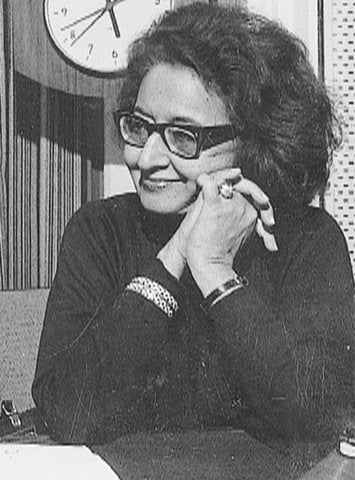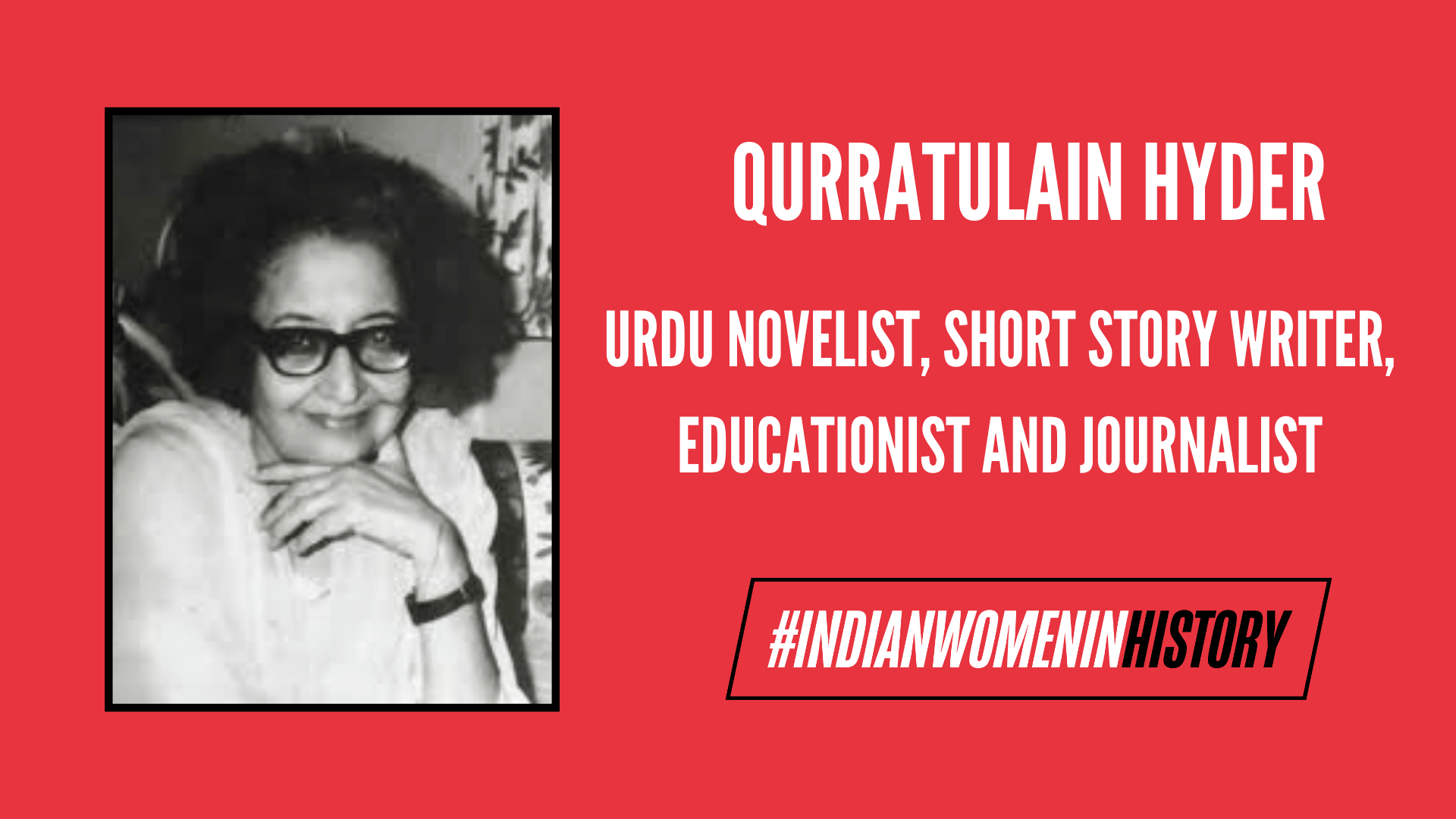I don’t have a great mission in life and I never thought it was necessary for a writer to have one… – Qurratulain Hyder
Qurratulain Hyder was an Urdu language novelist and short story writer, an educationist and a journalist with great caliber and influence. As a writer, she paved the path for future female writers of South Asia, mainly India and Pakistan. She wrote on topics usually considered “bold” for women and brought in the element of history in her writings. Through her works, she challenged the stereotypical representation of women in South Asia and portrayed them as capable individuals who are in no way lesser than any man. The female characters in her novels were strong and able women who, if given equal opportunities as men, could do wonders.
Through her writings, she aimed to change perceptions about women and the stereotypes attached with them. She made her mark in the world of Urdu literature and happens to be one of the first female Urdu novelists. She inspired many to take up her legacy and continue the work that she was doing.
Early life and work

Qurralutain Hyder
Popularly known by her nickname, Ainee Apa, Qurratulain Hyder was born on the 20th of January 1927 in Aligarh, Uttar Pradesh, India to Sajjad Haidar Yildarim and Nazar Zahra, who were Urdu literature novelists and short story writers. The inspiration for her name came from a notable Iranian poetess, Qurat-ul-Ain Tahira. The name literally means ‘calmness to the eyes.’ Ainee Apa took up novel-writing at a time when the world of Urdu literature was immersed in poetry and other similar literary works. In this aspect, she was one of the pioneers of novel and short story writing in Urdu. She was regarded as the ‘Grande Dame’ of Urdu literature because she influenced major transformation in the literature of this language by introducing a new genre and thought to it.
Qurratulain Hyder received her education from Indraprastha College, Delhi and Lucknow University’s Isabella Thoburn College with a degree in English literature. She started writing when she was just 11 years old. After completing her education, Qurratulain shifted to Pakistan to settle permanently, in 1947. During her time in Pakistan, she worked on documentary films. However, soon afterwards, she went to live in England and work for the BBC before returning to India in 1961 and lived there until her death. She never got married and lived alone for a long period.
Apart from being a novelist and a short story writer, she worked as a journalist on radio and magazines to earn a living. She worked with reputed publications like Imprinted and Illustrated Weekly of India and also attended sessions at various universities around the world as a guest lecturer. These prestigious universities included the universities of Chicago, Arizona, California, and Wisconsin. She also served as a visiting faculty at the Aligarh Muslim University at the Department of Urdu. She was in residency at the University of Iowa’s International Writing Program in 1979 and worked as a Professor Emeritus, Khan Abdul Ghaffar Khan Chair at Jamia Millia Islamia, New Delhi. She was one of the few writers who successfully touched the ground of high modernism and post-modernism.
Aag Ka Darya (River of Fire) and Hyder as a writer
Qurratulain Hyder was a gifted writer, in all senses of the word. She has 12 novels and four collections of short stories to her credit. Apart from this, she also translated various classics. Her writings displayed her fervour and love for literature. She was often compared to the likes of Milan Kundera, Gabriel García Márquez and most famously, her contemporary at the time, Ismat Chughtai. Hyder used a technique called stream of consciousness in her literary writings.
Stream of consciousness is a literary device, also known as interior monologue which is a narrative mode or device that depicts the multitudinous thoughts and feelings which pass through the mind. This style of literary writing can be seen in almost every novel and short story of Hyder’s. She dug deep into complex topics by presenting to her readers what her characters were thinking; their struggles and pain, weaknesses, thought processing, moral standing, feelings etc. This gave her readers a better insight of the dilemma that her characters were going through and thus, they could connect with them better and got immersed in the stories completely.
In the words of the literary critic, Zamir Ali Badaiyuni,
Ms Hyder is neither a philosopher nor a metaphysician. She is a novelist in the truest sense. Her concept of time is literary and cultural. Marcel Proust, French novelist; Virginia Woolf, an English fiction writer, and William Faulkner, the author of Sound and Fury, is an American novelist. Time is the major theme in their works and Qurratulain Hyder, inspired by them, chose time as a major theme in her novel, but her concept of time is purely cultural and historical.
One of Hyder’s best works to date is her novel ‘Aag ka Darya’ (River of Fire), in which she wrote about circumstances and consequences surrounding the partition of the subcontinent into Pakistan and India. The novel revolves around the struggles and agony of the people who believed in Pakistan. It tells the tale of the hardships faced by these people and the disappointments that they came across. The story originates from the un-partitioned Indian subcontinent in the fourth century BC, the time of Chandragupta Maurya and takes the readers through the period of partition and then to the post-Independence era in India and Pakistan. Hyder’s writing style in this novel is more historic than novelistic. She states incidents from the history and builds stories around them. She gave voices to the unseen, unheard, common characters of the partition and how their lives were hinged from the core during and after the partition; how the people who believed in Pakistan met their unexpected fates and how the leaders led their followers to an unnecessary and painful path.
The novel also made a political statement as Qurratulain Hyder clearly refused to accept the partition and the insanity of two-nation theory. Through powerful characters and their monologues, Hyder raised many questions on the partition, its necessity and its adversities and if it was worth all the hate and blood. Aag ka Darya is said to be “One of the best written novels of the Indian subcontinent.” On Aag ka Darya, Aamer Hussein of The Times Literary Supplement wrote that River of Fire is to Urdu fiction what One Hundred Years of Solitude (by Gabriel García Márquez) is to Hispanic literature. This novel was published in 1959 in Urdu language and in 1998 was translated in English by the author herself. In an article for Dawn, Asif Farrukhi, a Pakistani writer, wrote, “More than a partition novel, it portrays events that cast a long historical shadow and how history determines the fate of people. In the last part of the book, the emergent and upstart society of Pakistan is vividly portrayed. It seems that she could foresee the shape of things to come.”
Other notable works
Apart from Aag ka Darya, some of Qurratulain Hyder’s best works include Mere Bhi Sanam Khane (1949), Safina-e-Gham-e-Dil (1952), Patjhar ki Awaz (The Voice of Autumn) (1965), Raushni ki Raftar (The Speed of Light) (1982), the short novel Chaye ke Bagh (Tea Plantations) (1965); this was one of the four novellas including Dilruba, Sita Haran, Agle Janam Mohe Bitiya Na Kijo and the family chronicle Kar e Jahan Daraz Hai (The Work of the World Goes On).
She wrote a comprehensive documentary novel, based in volumes, called Gardish e Rang e Chaman, which spoke about the post 1857 era and the tragedies befalling women of respectable families. She wrote a novel called, Aakhir e Shab kay Hamsafar, on the Naxalite Movement and Bengal unrest. Her novel, Chandni Begum, was based on the general social condition of Muslims forty years after the partition.
Personality
Qurratulain Hyder was a woman of an intriguing personality. Mustansar Hussain Tarar, a well renowned Pakistani novelist, writer, host among other things, wrote a memorial for her when she passed away with the title, “The Queen is dead, long live fiction” in Dawn. An excerpt from the piece shed some light on the personality of Hyder from the point of view of a close friend, “One cannot claim that one knew her intimately or she was a friend; how can a giant be a friend of a lilliputian? She was a prima donna of Urdu fiction, she was moody, short-tempered, arrogant and at times unbearable; however, queens are supposed to be arrogant and if they choose to ignore or even insult their subjects then that is the trait of true royalty.”
Qurratulain Hyder was a reserved but a pleasant person to be in the company of. She kept her personal space intact and did not allow a lot of people in. Her colleagues and even her contemporaries spoke high of her writing caliber and how she had a strong command over Urdu novelty. Her personality reflected her fervor for writing. She had the charisma, intellect and personality fit for a writer. Her friends, colleagues and close ones remember her as someone who “kept her humour and her zest for living till almost the end.”
Though she did not actively campaign for it like Ismat Chugtai and others, Qurratulain Hyder is considered a feminist literary icon. Not only did she lay a foundation and paved the way for future Urdu novelists of South Asia, she also shunned gender stereotypes through her writings. She did not characterize women in typical and stereotypical molds and her female characters were as able as her male ones, however, they did not have equal opportunities – a basic representation of the South Asian society and patriarchy. Her four novellas namely, Chaye ke Bagh, Dilruba, Sita Haran, and Agle Janam Mohe Bitiya Na Kijo, Hyder explored the theme of gender injustice and deep-rooted misogyny in the South Asian region.
Struggles and controversies
Qurratulain Hyder faced a lot of backlash for her novel, Aag ka Darya. The novel and the uproar caused by it was the reason Hyder left Pakistan. She moved to England before settling in India permanently. The novel criticized the partition, two-nation theory and the basic idea of Pakistan. This caused uproar among the masses, particularly in Pakistan. This happens to be the biggest controversy of Hyder’s life and career. Apart from this, she was criticized for not acknowledging the sentiments of those who stayed behind in India after partition. She indeed reviewed such content and deleted in the English translation of the novel.
Apart from this, Qurratulain Hyder also faced criticism from critics who “Never endorsed her romance with the jagirdari (feudal) order, and her apparent empathy with a new Muslim élite who studied abroad and joined the colonial civil services.” They believed her to be an elitist writer and not a progressive one. One of her most ferocious contemporaries and critics was Ismat Chughtai who used her (Hyder) as a target practice in an essay entitled “Pom Pom Darling”, a reference to Ms Hyder’s elitist duck-shooting characters.
However, Qurratulain Hyder took the criticism with poise and grace and did not indulge in mudslinging.
Last years and death
Qurratulain Hyder passed away in a hospital in Noida, India on 21st August 2007, after a prolonged lung illness and old age. She is buried in the Jamia Millia Islamia cementary, New Delhi. Her death was mourned by people from across the globe, especially India and Pakistan. The Prime Minister of India at that time, Manmohan Singh said in his departing speech for Hyder that he is deeply grieved (by her demise). “She was a great teacher and scholar famous in India and abroad. She was one of the most celebrated and prolific writers of Urdu literature. Aag Ka Dariya, her magnum opus, is a landmark novel that explores the vast sweep of time and history. In her unfortunate passing away the country, especially Urdu literature, has lost a towering literary figure. She will be truly missed in literary circles in the country.”
Legacy
Qurratulain Hyder won various awards and accolades throughout her life. In 1989, for her novel, Aakhir-i-Shab ke Hamsafar (Travellers Unto the Night) she received the Jnanpith Award which is India’s highest literary award. In 1967, she won the Sahitya Akademi Award, the Soviet Land Nehru Award in 1967, the Ghalib Award in 1969 among others. In 2000, she also received the Bahadur Shah Zafar Award by the Urdu Academy in Delhi. In recognition of her outstanding contribution to Urdu literature, Qurratulain Hyder received the Padma Shri and Padma Bhushan by the Government of India, in 1985.
The legacy of Qurratulain Hyder lives on through the excellent pieces of literature she has blessed the world with.
About the author(s)
A Pakistani journalist and Culture & Gender scholar at the University of Sydney, Amna Nasir considers herself a hard-core feminist. She is a travel enthusiast and expresses herself through painting, sketching, photography and writing. As clichéd as it may sound, Amna believes in equality of all beings irrespective of their background, colour, gender, religion or ethnicity.




